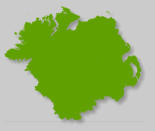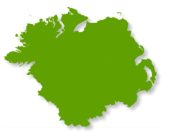





Summary
Large scale settlement of Ulster by
Scottish tenants began in the first
decade of the 17th century. Two
Scottish Lairds, Hamilton and
Montgomery, and the recalcitrant
Gaelic Warlord Sir Randell
McDonell, would initiate the
process.
It would expand dramatically beginning in 1610 with
the official Plantation of Ulster. Scores of Scottish and
English “Undertakers” would be granted proportions
of Ulster territory in which they established estates
settled by Scottish and English tenants.
By the mid 17th century the McClure surname was well
established in Northern Down, the Route of Antrim
including the Ballymoney and Ballymena region, and
in the Barony of Rapho in Donegal. The persistence of
the McClure surname in these territories can be verified
by census substitutes and ultimately by intensity
indexes based on the 1901 census.
The Ards Settlement:
Hamilton and Montgomery would
use the narrow sea passage between
Port Patrick and Donaghadee on the
Ards Peninsula to facilitate
movement of tenants to their new
estates. To support his new
settlements, Montgomery controlled
trade through the ports of Portpatrick in Ayrshire and
Donaghadee in Down. To this end, in 1617
Montgomery obtained a Royal Warrant which
attempted to limit the crossing between the two ports.
This likely accounts for the presence of two McClure’s
on the Ards in the 1630 Muster Roll. Additionally in
The McClure Family, the author identifies the presence
of three McClure brothers who settled in Saintfield
Down, Crumlin Antrim, and the third in Armagh.
Further references to locations thought to be associated
with these brothers are Knockbreda, Lisburn and
Ballymena. It is not known if these three brothers were
related to the Muster Roll McClures.
The Ballymena reference is of
particular interest. By 1620 William
Adair who owned estates near
Portpatrick had fallen on hard
financial times. In 1626 he acquired
newly-settled lands at Ballymena
from William Montgomery in
exchange for part of his patrimony
in Wigtownshire, and his son, Sir Robert, built the
castle as a centre for the new estate. This may accounts
for the presence of the McClures in Ballymena.
The Settlement in Donegal:
The early presence of the McClure’s in the Barony of
Rapho is based on the assumption that the spelling
McClere is a variant or misspelling of McClure.
The 1630 muster roll lists two
McCleres, John and Anthony, in
Rapho with Sir J. Wilson as the
Landlord of the Estate. A search of
Ulster Ancestry, lists “William
Wilson, Esq., granted 2,000 acres
called Aghagalla.” His Son was Sir
John Wilson, d. 1636.
No contemporary place name matches Aghagalla. It is
likely the place name references a 17th century
townland. A search of townlands.ie for similar
sounding townlands in Donegal found Aughagault.
Appended to the Aughagault reference are several
historic spellings.
1637 Aghagalla, Inq, Ult. Lethanach 24 CI1654-1659
Agagalty CS 111 Lethanach
It would be reasonable to assume the historic
plantation reference of Aghagalla is the modern day
townland Aughagault.
It also confirms that McClere was a
misspelling of MClure, as the
townland of Aughagult is but 2
miles from the townland of
Findrum. where in 1677 Richard
McClures was party to a land
deed. Both townlands are within
the District Electoral Division of
Convoy where we find the highest McClure surname
intensity in the 1901 census. Persistence of a surname is
not to be unexpected, but to find a surname persisting
in an area with a 2 mile radius over two centuries is
remarkable.
Donegal Origins:
Its unlikely the early origins of the McClures in
Donegal are associated with the Wigtown/Kirkbright
McClure homeland. It would be far more likely that
this region was settled by McClure’s from central or
northern Ayrshire, It is probable that passage would
have been by sea to the River Bann and Lough Swilly.
The Scottish homeland of the
Donegal Undertakers is in
Ayrshire. A “spider graph” can be
used to connect the Ulster and
Scottish estates of the
Undertakers.
The Route and the Glens
of Antrim:
By 1604 after decades of conflict Sir Randal
MacDonnell had come to an arrangement with King
Charles and had consolidated his territory within the
Route and Glens of Antrim.
Between 1609 and 1626
MacDonell had demensed 25
Lowland Scots to his holdings.
Tenure in Scotland was uncertain
with short leases and feu tenure
as major grievances. MacDonnell
attracted tenants with
particularly good terms of settlement including long
term leases. Nothing is known about these tenants but
Perceval Maxwell notes that;
“the size of the grants and the length of tenure
suggests that those who obtained the leases were
men of some substance. Such men would
undoubtedly drawn over other Scots after them.”
This was most certainly the case for by 1630
MacDonnell had 814 Scots and 142 English males on
his estates. They were drawn from the Western Isles,
Kintyre and Northern Ayrshire. While we have no
direct evidence it is likely that McClures from Northern
Ayrshire were among them.
Return to Top


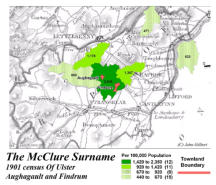
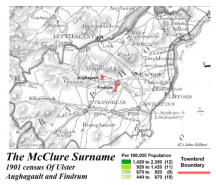
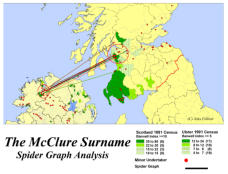

© John Gilbert
Created by SurnameOrigins





